A Review of Urban Planning Research for Climate Change
Abstract
1. Introduction
2. Methods and Data Sources
3. Research Direction and Regional Distribution
3.1. Research Direction
3.2. Regional Distribution
4. Research Focus and Academic Groupings
4.1. Research Focus Analysis
4.2. Academic Groupings
4.3. Landmark References
5. Intellectual Dynamics
5.1. Timeline Map Analysis
5.2. The Strongest Citation Burst Detection Analysis
6. Conclusions
Acknowledgments
Author Contributions
Conflicts of Interest
References
- Betsill, M.M. Mitigating climate change in US cities: Opportunities and obstacles. Local Environ. 2001, 6, 393–406. [Google Scholar] [CrossRef]
- Lindseth, G. The Cities for Climate Protection Campaign (CCPC) and the framing of local climate policy. Local Environ. 2004, 9, 325–336. [Google Scholar] [CrossRef]
- Grimm, N.B.; Faeth, S.H.; Golubiewski, N.E.; Redman, C.L.; Wu, J.; Bai, X.; Briggs, J.M. Global change and the ecology of cities. Science 2008, 319, 756–760. [Google Scholar] [CrossRef] [PubMed]
- Pacala, S.; Socolow, R. Stabilization wedge: Solving the climate problem for the next 50 years with current technologies. Science 2004, 305, 968–972. [Google Scholar] [CrossRef] [PubMed]
- The Chicago Department of Environment. Chicago Climate Action Plan 2008. Available online: http://www.chicagoclimateaction.org/filebin/pdf/report/CorporateRisk2008August5.pdf (accessed on 1 March 2009).
- Lindley, S.J.; Handley, J.F.; Theuray, N.; Peet, E.; Mcevoy, D. Adaptation strategies for climate change in the urban environment: Assessing climate change related risk in UK urban areas. J. Risk Res. 2006, 9, 543–568. [Google Scholar] [CrossRef]
- Chen, Y.; Liu, Z.Y. The rise of mapping knowledge domain. Stud. Sci. Sci. 2005, 23, 149–154. [Google Scholar]
- Börner, K.; Chen, C.; Boyack, K.W. Visualizing knowledge domains. Annu. Rev. Inf. Sci. Technol. 2003, 37, 179–255. [Google Scholar] [CrossRef]
- Chen, C.; Ibekwe-SanJuan, F.; Hou, J. The structure and dynamics of cocitation clusters: A multiple-perspective cocitation analysis. J. Am. Soc. Inf. Sci. Technol. 2010, 61, 1386–1409. [Google Scholar] [CrossRef]
- Chen, C.; Hu, Z.; Liu, S.; Tseng, H. Emerging trends in regenerative medicine: A scientometric analysis in CiteSpace. Expert Opin. Biol. Ther. 2012, 12, 593–608. [Google Scholar] [CrossRef] [PubMed]
- Chen, C. The CiteSpace Manual 2014. Available online: https://wenku.baidu.com/view/21638405a417866fb84a8eba.html (accessed on 29 November 2017).
- Cobo, M.J.; López-Herrera, A.G.; Herrera-Viedma, E.; Herrera, F. Science mapping software tools: Review, analysis, and cooperative study among tools. J. Am. Soc. Inf. Sci. Technol. 2011, 62, 1382–1402. [Google Scholar] [CrossRef]
- Kamalski, J.; Kirby, A. Bibliometrics and urban knowledge transfer. Cities 2012, 29, 3–8. [Google Scholar] [CrossRef]
- Fu, Y.; Zhang, X. Trajectory of urban sustainability concepts: A 35-year bibliometric analysis. Cities 2017, 60, 113–123. [Google Scholar] [CrossRef]
- Chen, C. Searching for intellectual turning points: Progressive knowledge domain visualization. Proc. Natl. Acad. Sci. USA 2004, 101 (Suppl. 1), 5303–5310. [Google Scholar] [CrossRef] [PubMed]
- Leydesdorff, L.; Persson, O. Mapping the geography of science: Distribution patterns and networks of relations among cities and insititutes. J. Am. Soc. Inf. Sci. Technol. 2010, 61, 1622–1634. [Google Scholar] [CrossRef]
- Yu, D. A scientometrics review on aggregation operator research. Scientometrics 2015, 105, 115–133. [Google Scholar] [CrossRef]
- Small, H.; Garfield, E. The geography of science: Disciplinary and national mappings. J. Inf. Sci. 1985, 11, 147–159. [Google Scholar] [CrossRef]
- Cui, L.; Shi, J. Urbanization and its environmental effects in Shanghai, China. Urban Clim. 2012, 2, 1–15. [Google Scholar] [CrossRef]
- Jamei, E.; Jamei, Y.; Rajagopalan, P.; Ossen, D.R.; Roushenas, S. Effect of built-up ratio on the variation of air temperature in a heritage city. Sustain. Cities Soc. 2015, 14, 280–292. [Google Scholar] [CrossRef]
- Bolund, P.; Hunhammar, S. Ecosystem services in urban areas. Ecol. Econ. 1999, 29, 293–301. [Google Scholar] [CrossRef]
- Gurney, K.R.; Razlivanov, I.; Yang, S.; Zhou, Y.; Benes, B. Quantification of Fossil Fuel CO2 Emissions on the Building/Street Scale for a Large US City. Environ. Sci. Technol. 2012, 46, 12194–12202. [Google Scholar] [CrossRef] [PubMed]
- Liu, Z.; Liang, S.; Geng, Y.; Xue, B.; Xi, F.; Pan, Y.; Zhang, T.; Fujita, T. Features, trajectories and driving forces for energy-related GHG emissions from Chinese mega cites: The case of Beijing, Tianjin, Shanghai and Chongqing. Energy 2012, 37, 245–254. [Google Scholar] [CrossRef]
- Dixon, P.G.; Mote, T.L. Patterns and causes of Atlanta’s urban heat island-initiated precipitation. J. Appl. Meteorol. 2003, 42, 1273–1284. [Google Scholar] [CrossRef]
- Diem, J.E.; Brown, D.P. Anthropogenic impacts on summer precipitation in central Arizona, USA. Prof. Geogr. 2003, 55, 343–355. [Google Scholar]
- Burley, J.G.; McAllister, R.R.J.; Collins, K.A.; Lovelock, C.E. Integration, synthesis and climate change adaptation: A narrative based on coastal wetlands at the regional scale. Reg. Environ. Chang. 2012, 12, 581–593. [Google Scholar] [CrossRef]
- Müller, A.; Reiter, J.; Weiland, U. Assessment of urban vulnerability towards floods using an indicator-based approach-a case study for Santiago de Chile. Nat. Hazards Earth Syst. Sci. 2011, 11, 2107–2123. [Google Scholar] [CrossRef]
- Wilhelmi, O.V.; Hayden, M.H. Connecting people and place: A new framework for reducing urban vulnerability to extreme heat. Environ. Res. Lett. 2010, 5, 014021. [Google Scholar] [CrossRef]
- Gwilliam, J.; Fedeski, M.H.; Lindley, S.; Theuray, N. Methods for assessing risk from climate hazards in urban areas. Proc. Inst. Civ. Eng. Munic. Eng. 2006, 159, 245–253. [Google Scholar] [CrossRef]
- Dugord, P.A.; Lauf, S.; Schuster, C.; Kleinschmit, B. Land use patterns, temperature distribution, and potential heat stress risk—The case study Berlin, Germany. Comput. Environ. Urban Syst. 2014, 48, 86–98. [Google Scholar] [CrossRef]
- Viegas, C.V.; Saldanha, D.L.; Bond, A.; Ribeiro, J.L.D.; Selig, P.M. Urban land planning: The role of a Master Plan in influencing local temperatures. Cities 2013, 35, 1–13. [Google Scholar] [CrossRef]
- Blair, R.B. Land use and avian species diversity along an urban gradient. Ecol. Appl. 1996, 6, 506–519. [Google Scholar] [CrossRef]
- Ortega-Álvarez, R.; MacGregor-Fors, I. Living in the big city: Effects of urban land-use on bird community structure, diversity, and composition. Landsc. Urban Plan. 2009, 90, 189–195. [Google Scholar] [CrossRef]
- Emadodin, I.; Alireza, T.; Rajaei, M. Effects of urban sprawl on local climate: A case study, north central Iran. Urban Clim. 2016, 17, 230–247. [Google Scholar] [CrossRef]
- Kim, H.; Kim, Y.; Song, S.; Lee, H.W. Impact of future urban growth on regional climate changes in the Seoul Metropolitan Area, Korea, Ireland. Sci. Total Environ. 2016, 571, 355–363. [Google Scholar] [CrossRef] [PubMed]
- He, C.; Zhao, Y.; Huang, Q.; Zhang, Q.; Zhang, D. Alternative future analysis for assessing the potential impact of climate change on urban landscape dynamics. Sci. Total Environ. 2015, 532, 48–60. [Google Scholar] [CrossRef] [PubMed]
- Parry, M.; Chandler, T.J. The climate of London. Geogr. J. 1966, 132, 320–321. [Google Scholar] [CrossRef]
- Auer, A.H. Correlation of land use and cover with meteorological anomalies. J. Appl. Meteorol. 1978, 17, 636–643. [Google Scholar] [CrossRef]
- Alexander, P.J.; Fealy, R.; Mills, G.M. Simulating the impact of urban development pathways on the local climate: A scenario-based analysis in the greater Dublin region, Ireland. Landsc. Urban Plan. 2016, 152, 72–89. [Google Scholar] [CrossRef]
- Lafortezza, R.; Davies, C.; Sanesi, G.; Konijnendijk, C.C. Green Infrastructure as a tool to support spatial planning in European urban regions. iFor. Biogeosci. For. 2013, 6, 102–108. [Google Scholar] [CrossRef]
- Amorim, J.H.; Rodrigues, V.; Tavares, R.; Valente, J.; Borrego, C. CFD modeling of the aerodynamic effect of trees on urban air pollution dispersion. Sci. Total Environ. 2013, 461–462, 541–551. [Google Scholar] [CrossRef] [PubMed]
- Lehmann, I.; Mathey, J.; Rößler, S.; Bräuer, A.; Goldberg, V. Urban vegetation structure types as a methodological approach for identifying ecosystem services—Application to the analysis of micro-climatic effects. Ecol. Indic. 2014, 42, 58–72. [Google Scholar] [CrossRef]
- Demuzere, M.; Orru, K.; Heidrich, O.; Olazabal, E.; Geneletti, D. Mitigating and adapting to climate change: Multi-functional and multi-scale assessment of green urban infrastructure. J. Environ. Manag. 2014, 146, 107–115. [Google Scholar] [CrossRef] [PubMed]
- Geneletti, D.; Zardo, L. Ecosystem-based adaptation in cities: An analysis of European urban climate adaptation plans. Land Use Policy 2016, 50, 38–47. [Google Scholar] [CrossRef]
- Rafael, S.; Martins, H.; Carvalho, E.S.D.; Borrego, C.; Lopes, M. Influence of urban resilience measures in the magnitude and behavior of energy fluxes in the city of Porto (Portugal) under a climate. Sci. Total Environ. 2016, 566–567, 1500–1510. [Google Scholar] [CrossRef] [PubMed]
- Setaih, K.; Hamza, N.; Mohammed, M.A.; Dudek, S.; Townshend, T. CFD modeling as a tool for assessing outdoor thermal comfort conditions in urban settings in hot arid climates. ITcon 2014, 19, 248–269. [Google Scholar]
- Zölch, T.; Maderspacher, J.; Wamsler, C.; Pauleit, S. Using green infrastructure for urban climate-proofing: An evaluation of heat mitigation measures at the micro-scale. Urban For. Urban Green. 2016, 20, 305–316. [Google Scholar] [CrossRef]
- Ketterer, C.; Matzarakis, A. Human-biometeorological assessment of heat stress reduction by replanning measures in Stuttgart, Germany. Landsc. Urban Plan. 2014, 122, 78–88. [Google Scholar] [CrossRef]
- Kotzee, I.; Reyers, B. Piloting a social-ecological index for measuring flood resilience: A composite index approach. Ecol. Indic. 2016, 60, 45–53. [Google Scholar] [CrossRef]
- Hung, H.C.; Yang, C.Y.; Chien, C.Y.; Liu, Y.C. Building resilience: Mainstreaming community participation into integrated assessment of resilience to climatic hazards in metropolitan land use management. Land Use Policy 2016, 50, 48–58. [Google Scholar] [CrossRef]
- Bulkeley, H.; Betsill, M. Rethinking Sustainable Cities: Multilevel Governance and the ‘Urban’ Politics of Climate Change. Environ. Politics 2005, 14, 42–63. [Google Scholar] [CrossRef]
- Ng, M.K. A critical review of Hong Kong’s proposed climate change strategy and action agenda. Cities 2012, 29, 88–98. [Google Scholar] [CrossRef]
- Walker, B.J.A. Institutional barriers to climate change adaptation in decentralised governance structures: Transport planning in England. Urban Stud. 2015, 52, 2250–2266. [Google Scholar] [CrossRef]
- Funfgeld, H. Facilitating local climate change adaptation through transnational municipal networks. Curr. Opin. Environ. Sustain. 2015, 12, 67–73. [Google Scholar] [CrossRef]
- McEvoy, D. Adaptation and mitigation in urban areas: Synergies and conflicts. Proc. Inst. Civ. Eng. Munic. Eng. 2006, 159, 185–191. [Google Scholar] [CrossRef]
- Poyar, K.A.; Beller-Simms, N. Early Responses to Climate Change: An Analysis of Seven US State and Local Climate Adaptation Planning Initiatives. Weather Clim. Soc. 2010, 2, 237–248. [Google Scholar] [CrossRef]
- Santamouris, M. Cooling the cities—A review of reflective and green roof mitigation technologies to fight heat island and improve comfort in urban environments. Sol. Energy 2014, 103, 682–703. [Google Scholar] [CrossRef]
- Kjellstrom, T.; Friel, S.; Dixon, J.; Corvalan, C.; Rehfuess, E.; Campbell-Lendrum, D.; Gore, F.; Bartram, J. Urban Environmental Health Hazards and Health Equity. J. Urban Health Bull. N. Y. Acad. Med. 2007, 84, 86–97. [Google Scholar] [CrossRef] [PubMed]
- Luber, G.; Mcgeehin, M. Climate Change and Extreme Heat Events. Am. J. Prev. Med. 2008, 35, 429–435. [Google Scholar] [CrossRef] [PubMed]
- Jackson, R. Preparing the US health community for climate change. Annu. Rev. Public Health 2008, 29, 57–60. [Google Scholar] [CrossRef] [PubMed]
- Campbell-Lendrum, D.; Corvalan, C. Climate Change and Developing-Country Cities: Implications for Environmental Health and Equity. J. Urban Health 2007, 84, 109–117. [Google Scholar] [CrossRef] [PubMed]
- Patz, J.; Campbelllendrum, D.; Gibbs, H.; Woodruff, R. Health impact assessment of global climate change: Expanding on comparative risk assessment approaches for policy making. Annu. Rev. Public Health 2008, 29, 27–39. [Google Scholar] [CrossRef] [PubMed]
- Kinney, P.L.; O’Neill, M.S.; Bell, M.L.; Schwartz, J. Approaches for estimating effects of climate change on heat-related deaths: Challenges and opportunities. Environ. Sci. Policy 2008, 11, 87–96. [Google Scholar] [CrossRef]
- Younger, M.; Morrowalmeida, H.R.; Vindigni, S.M.; Dannenberg, A.L. The Built Environment, Climate Change, and Health Opportunities for Co-Benefits. Am. J. Prev. Med. 2008, 35, 517–526. [Google Scholar] [CrossRef] [PubMed]
- ONeill, M.S.; Ebi, K.L. Temperature Extremes and Health: Impacts of Climate Variability and Change in the United States. J. Occup. Environ. Med. 2009, 51, 13–15. [Google Scholar] [CrossRef] [PubMed]
- ONeill, M.S.; Carter, R.; Kish, J.K.; Gronlund, C.J.; White-Newsome, J.L.; Manarolla, X.; Zanobetti, A.; Schwartzd, J.D. Preventing heat-related morbidity and mortality: New approaches in a changing climate. Maturitas 2009, 64, 98–103. [Google Scholar] [CrossRef] [PubMed]
- Folke, C.; Hahn, T.; Olsson, P.; Norberg, J. Adaptive governance of social-ecological systems. Annu. Rev. Environ. Resour. 2005, 30, 441–473. [Google Scholar] [CrossRef]
- Smit, B.; Wandel, J. Adaptation, adaptive capacity and vulnerability. Glob. Environ. Chang. 2006, 16, 282–292. [Google Scholar] [CrossRef]
- Bulkeley, H.; Kern, K. Local Government and the Governing of Climate Change in Germany and the UK. Urban Stud. 2006, 43, 2237–2259. [Google Scholar] [CrossRef]
- Wheeler, S. State and Municipal Climate Change Plans: The First Generation. J. Am. Plan. Assoc. 2008, 74, 481–496. [Google Scholar] [CrossRef]
- Pickett, S.T.A.; Cadenasso, M.L.; Grove, J.M. Resilient cities: Meaning, models, and metaphor for integrating the ecological, socio-economic, and planning realms. Landsc. Urban Plan. 2004, 69, 369–384. [Google Scholar] [CrossRef]
- Campbell, S. Green Cities, Growing Cities, Just Cities? Urban Planning and the Contradictions of Sustainable Development. J. Am. Plan. Assoc. 2007, 26, 296–312. [Google Scholar] [CrossRef]
- Semenza, J.C.; McCullough, J.E.; Flanders, W.D.; McGeehin, M.A.; Lumpkin, J.R. Excess hospital admissions during the July 1995 heat wave in Chicago. Am. J. Prev. Med. 1999, 16, 269–277. [Google Scholar] [CrossRef]
- Adger, W.N. Vulnerability. Glob. Environ. Chang. 2006, 16, 268–281. [Google Scholar] [CrossRef]
- MCkinney, M.I. Urbanization, Biodiversity, and Conservation. BioScience 2002, 52, 883–890. [Google Scholar] [CrossRef]
- Seager, R.; Ting, M.; Held, I.; Kushnir, Y.; Lu, J.; Vecchi, G.; Huang, H.; Harnik, N.; Leetmaa, A.; Lau, N.; et al. Model Projections of an Imminent Transition to a More Arid Climate in Southwestern North America. Science 2007, 316, 1181–1184. [Google Scholar] [CrossRef] [PubMed]
- Arnfield, A.J. Two decades of urban climate research: A review of turbulence, exchanges of energy and water, and the urban heat island. Int. J. Climatol. 2003, 23, 1–26. [Google Scholar] [CrossRef]
- Rosenfeld, D. Suppression of Rain and Snow by Urban and Industrial Air Pollution. Science 2000, 287, 1793–1796. [Google Scholar] [CrossRef] [PubMed]
- Fitter, A.H.; Fitter, R.S. Rapid changes in flowering time in British plants. Science 2002, 296, 1689–1691. [Google Scholar] [CrossRef] [PubMed]
- Voogt, J.A.; Oke, T.R. Thermal remote sensing of urban climates. Remote Sens. Environ. 2003, 86, 370–384. [Google Scholar] [CrossRef]
- McGranahan, G.; Balk, D.; Anderson, B. The rising tide: Assessing the risks of climate change and human settlements in low elevation coastal zones. Environ. Urban. 2007, 19, 17–37. [Google Scholar] [CrossRef]
- Taha, H. Urban climates and heat islands: Albedo, evapotranspiration, and anthropogenic heat. Energy Build. 1997, 25, 99–103. [Google Scholar] [CrossRef]
- Brazel, A.; Selover, N.; Vose, R.; Heisler, G. The tale of two climates-Baltimore and Phoenix urban LTER sites. Clim. Res. 2000, 15, 123–135. [Google Scholar] [CrossRef]
- Whitford, V.; Ennos, A.R.; Handley, J.F. “City form and natural process”—Indicators for the ecological performance of urban areas and their application to Merseyside, UK. Landsc. Urban Plan. 2001, 57, 91–103. [Google Scholar] [CrossRef]
- Tzoulas, K.; Korpela, K.; Venn, S.; Yli-Pelkonen, V.; Kazmierczak, A.; Niemela, J.; James, P. Promoting ecosystem and human health in urban areas using green infrastructure: A literature review. Landsc. Urban Plan. 2007, 81, 167–178. [Google Scholar] [CrossRef]
- Gill, S.E.; Handley, J.F.; Ennos, A.R.; Pauleit, S. Adapting cities for climate change: The role of the green infrastructure. Built Environ. 2007, 33, 115–133. [Google Scholar] [CrossRef]
- Bowler, D.E.; Buyung-Ali, L.; Knight, T.M.; Pullin, A.S. Urban greening to cool towns and cities: A systematic review of the empirical evidence. Landsc. Urban Plan. 2010, 97, 147–155. [Google Scholar] [CrossRef]
- Watson, V. ‘The planned city sweeps the poor away...’: Urban planning and 21st century urbanisation. Prog. Plan. 2009, 72, 151–193. [Google Scholar] [CrossRef]
- Yu, M.; Carmichael, G.R.; Zhu, T.; Cheng, Y. Sensitivity of predicted pollutant levels to urbanization in China. Atmos. Environ. 2012, 60, 544–554. [Google Scholar] [CrossRef]
- Debbage, N.; Shepherd, J.M. The urban heat island effect and city contiguity. Comput. Environ. Urban Syst. 2015, 54, 181–194. [Google Scholar] [CrossRef]
- Kong, F.H.; Yin, H.; James, P.; Hutyra, L.R.; He, H. Effects of spatial pattern of greenspace on urban cooling in a large metropolitan area of eastern China. Landsc. Urban Plan. 2014, 128, 35–47. [Google Scholar] [CrossRef]
- Kong, F.H.; Yin, H.; Wang, C.; Cavan, G.; James, P. A satellite image-based analysis of factors contributing to the green-space cool island intensity on a city scale. Urban For. Urban Green. 2014, 13, 846–853. [Google Scholar] [CrossRef]
- Maimaitiyiming, M.; Ghulam, A.; Tiyip, T.; Pla, F.; Latorre-Carmona, P.; Halik, U.; Sawut, M.; Caetano, M. Effects of green space spatial pattern on land surface temperature: Implications for sustainable urban planning and climate change adaptation. ISPRS J. Photogramm. Remote Sens. 2014, 89, 59–66. [Google Scholar] [CrossRef]
- Cavan, G.; Lindley, S.; Jalayer, F.; Yeshitela, K.; Pauleit, S.; Renner, F.; Gill, S.; Capuano, P.; Nebebe, A.; Woldegerima, T. Urban morphological determinants of temperature regulating ecosystem services in two African cities. Ecol. Indic. 2014, 42, 43–57. [Google Scholar] [CrossRef]
- Wilby, R.L.; Keenan, R. Adapting to flood risk under climate change. Prog. Phys. Geogr. 2012, 36, 348–378. [Google Scholar] [CrossRef]
- Gober, P.; Brazel, A.J.; Quay, R.; Rossi, S. Using Watered Landscapes to Manipulate Urban Heat Island Effects: How Much Water Will It Take to Cool Phoenix? J. Am. Plan. Assoc. 2010, 76, 109–121. [Google Scholar] [CrossRef]
- Sampson, N.R.; Gronlund, C.J.; Buxton, M.A.; Catalano, L.; White-Newsome, J.L.; Conlon, K.C.; O’Neill, M.S.; McCormick, S.; Parker, E.A. Staying cool in a changing climate: Reaching vulnerable populations during heat events. Glob. Environ. Chang. Hum. Policy Dimens. 2013, 23, 475–484. [Google Scholar] [CrossRef]
- Weber, S.; Sadoff, N.; Zell, E.; Sherbinin, A.D. Policy-relevant indicators for mapping the vulnerability of urban populations to extreme heat events: A case study of Philadelphia. Appl. Geogr. 2015, 63, 231–243. [Google Scholar] [CrossRef]
- Kumar, P.; Geneletti, D.; Nagendra, H. Spatial assessment of climate change vulnerability at city scale: A study in Bangalore, India. Land Use Policy 2016, 58, 514–532. [Google Scholar] [CrossRef]
- Horton, R.M.; Gornitz, V.; Bader, D.A.; Ruane, A.C.; Goldberg, R.; Rosenzweig, C. Climate Hazard Assessment for Stakeholder Adaptation Planning in New York City. J. Appl. Meteorol. Climatol. 2011, 50, 2247–2266. [Google Scholar] [CrossRef]
- Musacchio, L.R. The scientific basis for the design of landscape sustainability: A conceptual framework for translational landscape research and practice of designed landscapes and the six Es of landscape sustainability. Landsc. Ecol. 2009, 24, 993–1002. [Google Scholar] [CrossRef]
- Milan, B.F.; Creutzig, F. Reducing urban heat wave risk in the 21st century. Curr. Opin. Environ. Sustain. 2015, 14, 221–231. [Google Scholar] [CrossRef]
- Suarez, M.; Gómez-Baggethun, E.; Benayas, J.; Tilbury, D. Towards an Urban Resilience Index: A Case Study in 50 Spanish Cities. Sustainability 2016, 8, 744. [Google Scholar] [CrossRef]
- Roy, M. Planning for sustainable urbanisation in fast growing cities: Mitigation and adaptation issues addressed in Dhaka, Bangladesh. Habitat Int. 2009, 33, 276–286. [Google Scholar] [CrossRef]
- Blanco, H.; Alberti, M.; Forsyth, A.; Krizek, K.J.; Rodríguez, D.A.; Talen, E.; Ellis, C. Hot, congested, crowded and diverse: Emerging research agendas in planning. Prog. Plan. 2009, 71, 153–205. [Google Scholar] [CrossRef]
- Blanco, H.; Alberti, M.; Olshansky, R.; Chang, S.; Wheeler, S.M. Shaken, shrinking, hot, impoverished and informal: Emerging research agendas in planning. Prog. Plan. 2009, 2, 195–250. [Google Scholar] [CrossRef]
- House-TEPers, L.A.; Chang, H. Modeling the impact of land use and climate change on neighborhood-scale evaporation and nighttime cooling: A surface energy balance approach. Landsc. Urban Plan. 2011, 103, 139–155. [Google Scholar] [CrossRef]
- Reyer, C.; Bachinger, J.; Bloch, R.; Hattermann, F.F.; Ibisch, P.L. Climate change adaptation and sustainable regional development: A case study for the Federal State of Brandenburg, Germany. Reg. Environ. Chang. 2012, 12, 523–542. [Google Scholar] [CrossRef]
- Picketts, I.M.; Dery, S.; Curry, J.A. Incorporating climate change adaptation into local plans. J. Environ. Plan. Manag. 2014, 57, 984–1002. [Google Scholar] [CrossRef]
- Hamin, E.M.; Gurran, N.; Emlinger, A.M. Barriers to Municipal Climate Adaptation: Examples From Coastal Massachusetts’ Smaller Cities and Towns. J. Am. Plan. Assoc. 2014, 80, 110–122. [Google Scholar] [CrossRef]
- Muller, N.; Kuttler, W.; Barlag, A.B. Counteracting urban climate change: Adaptation measures and their effect on thermal comfort. Theor. Appl. Climatol. 2014, 115, 243–257. [Google Scholar] [CrossRef]
- Abreu-Harbich, L.V.; Labaki, L.C.; Matzarakis, A. Thermal bioclimate as a factor in urban and architectural planning in tropical climates—The case of Campinas, Brazil. Urban Ecosyst. 2014, 17, 489–500. [Google Scholar] [CrossRef]
- Jamei, E.; Rajagopalan, P.; Seyedmahmoudian, M.; Jamei, Y. Review on the impact of urban geometry and pedestrian level greening on outdoor thermal comfort. Renew. Sustain. Energy Rev. 2016, 54, 1002–1017. [Google Scholar] [CrossRef]
- Rodríguez Algeciras, J.A.; Coch, H.; De la Paz Pérez, G.; Chaos Yeras, M.; Matzarakis, A. Human thermal comfort conditions and urban planning in hot-humid climates-The case of Cuba. Int. J. Biometerol. 2016, 60, 1151–1164. [Google Scholar] [CrossRef] [PubMed]
- Algeciras, J.A.R.; Matzarakis, A. Quantification of thermal bioclimate for the management of urban design in Mediterranean climate of Barcelona, Spain. Int. J. Biometerol. 2016, 60, 1261–1270. [Google Scholar] [CrossRef] [PubMed]
- Meerow, S.; Stults, M. Comparing Conceptualizations of Urban Climate Resilience in Theory and Practice. Sustainability 2016, 8, 701. [Google Scholar] [CrossRef]
- Picketts, I.M.; Werner, A.T.; Murdock, T.Q.; Curry, J.; Déry, S.J.; Dyer, D. Planning for climate change adaptation: Lessons learned from a community-based workshop. Environ. Sci. Policy 2012, 17, 82–93. [Google Scholar] [CrossRef]
- Reckien, D.; Flacke, J.; Dawson, R.J.; Heidrich, O.; Olazabal, M.; Foley, A.; Hamann, J.J.P.; Orru, H.; Salvia, M.; Hurtado, S.D. Climate change response in Europe: What’s the reality? Analysis of adaptation and mitigation plans from 200 urban areas in 11 countries. Clim. Chang. 2014, 122, 331–339. [Google Scholar] [CrossRef]
- Reckien, D.; Flacke, J.; Olazabal, M.; Heidrich, O. The Influence of Drivers and Barriers on Urban Adaptation and Mitigation Plans—An Empirical Analysis of European Cities. PLoS ONE 2015, 122, 331–340. [Google Scholar] [CrossRef] [PubMed]
- Wamsler, C. Mainstreaming ecosystem-based adaptation: Transformation toward sustainability in urban governance and planning. Ecol. Soc. 2015, 20, 30–49. [Google Scholar] [CrossRef]
- Wamsler, C. Making headway in climate policy mainstreaming and ecosystem-based adaptation: Two pioneering countries, different pathways, one goal. Clim. Chang. 2016, 137, 71–87. [Google Scholar] [CrossRef]
- Gore, C.D. The Limits and Opportunities of Networks: Municipalities and Canadian Climate Change Policy. Rev. Policy Res. 2010, 27, 27–46. [Google Scholar] [CrossRef]
- Santamouris, M. Regulating the damaged thermostat of the cities—Status, impacts and mitigation challenges. Energy Build. 2015, 91, 43–59. [Google Scholar] [CrossRef]
- Haunschild, R.; Bornmann, L.; Marx, W. Climate Change Research in View of Bibliometrics. PLoS ONE 2016, 11, e0160393. [Google Scholar] [CrossRef] [PubMed]
- Ng, E.; Ren, C. China’s adaptation to climate & urban climatic changes: A critical review. Urban Clim. 2017, in press. [Google Scholar]
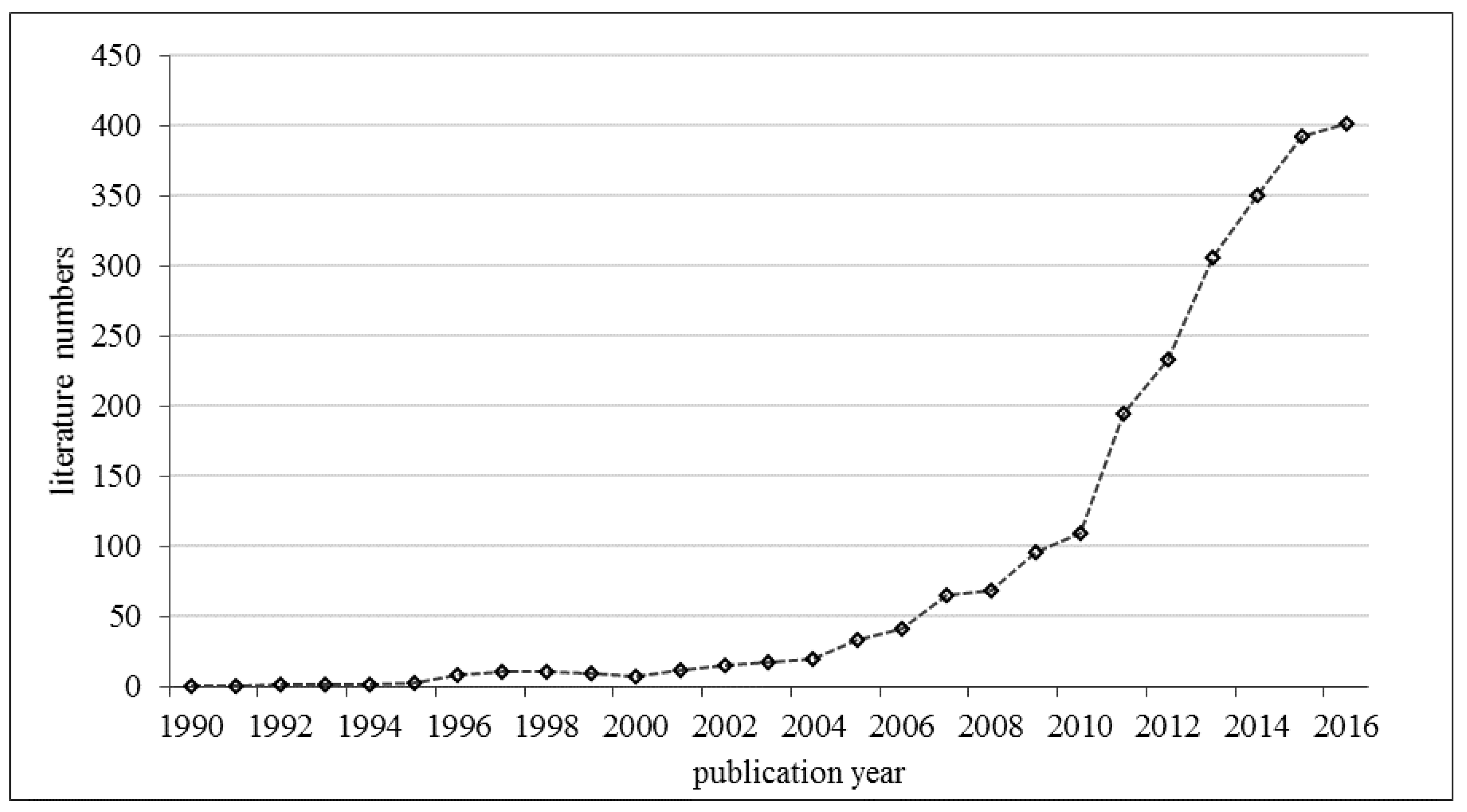
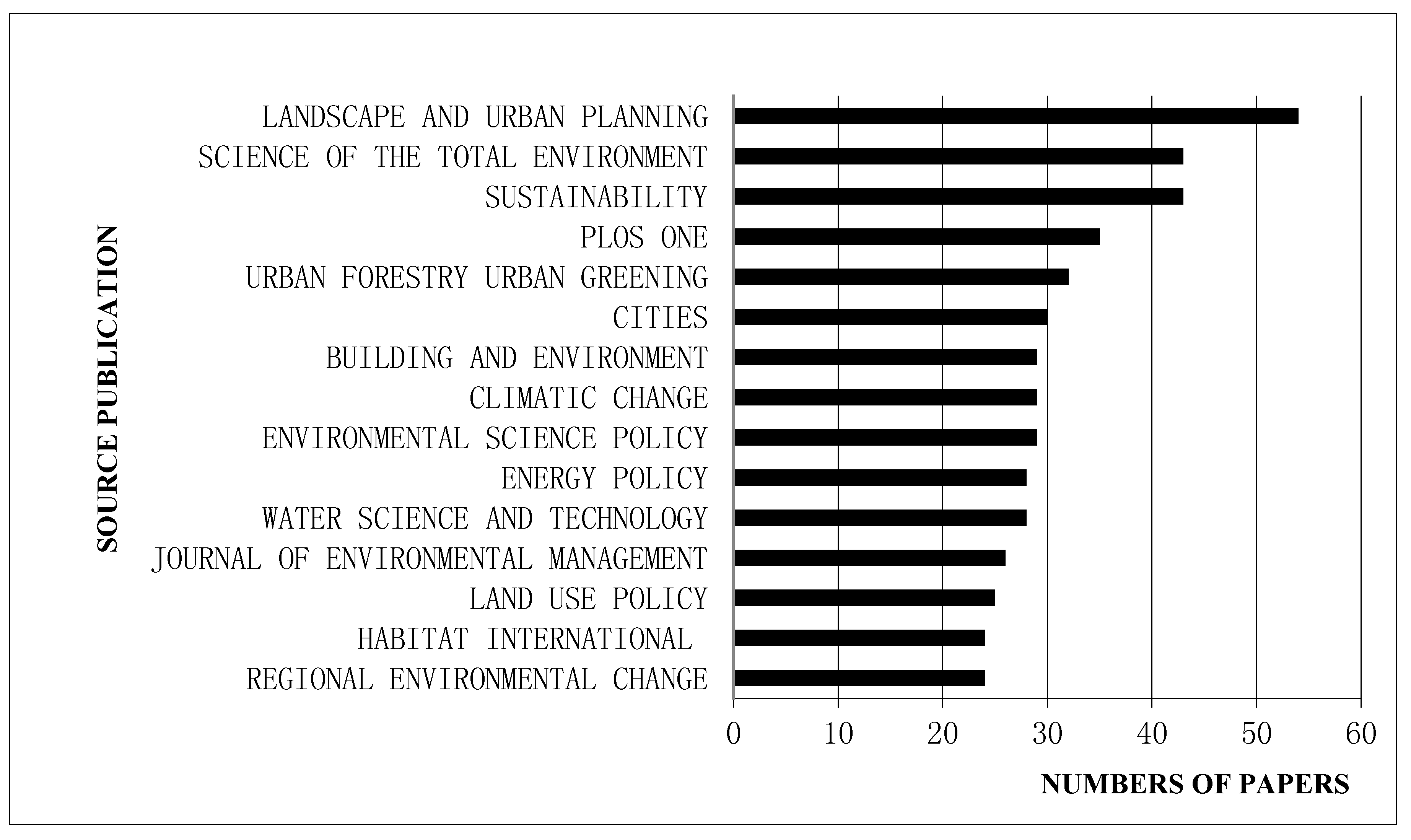
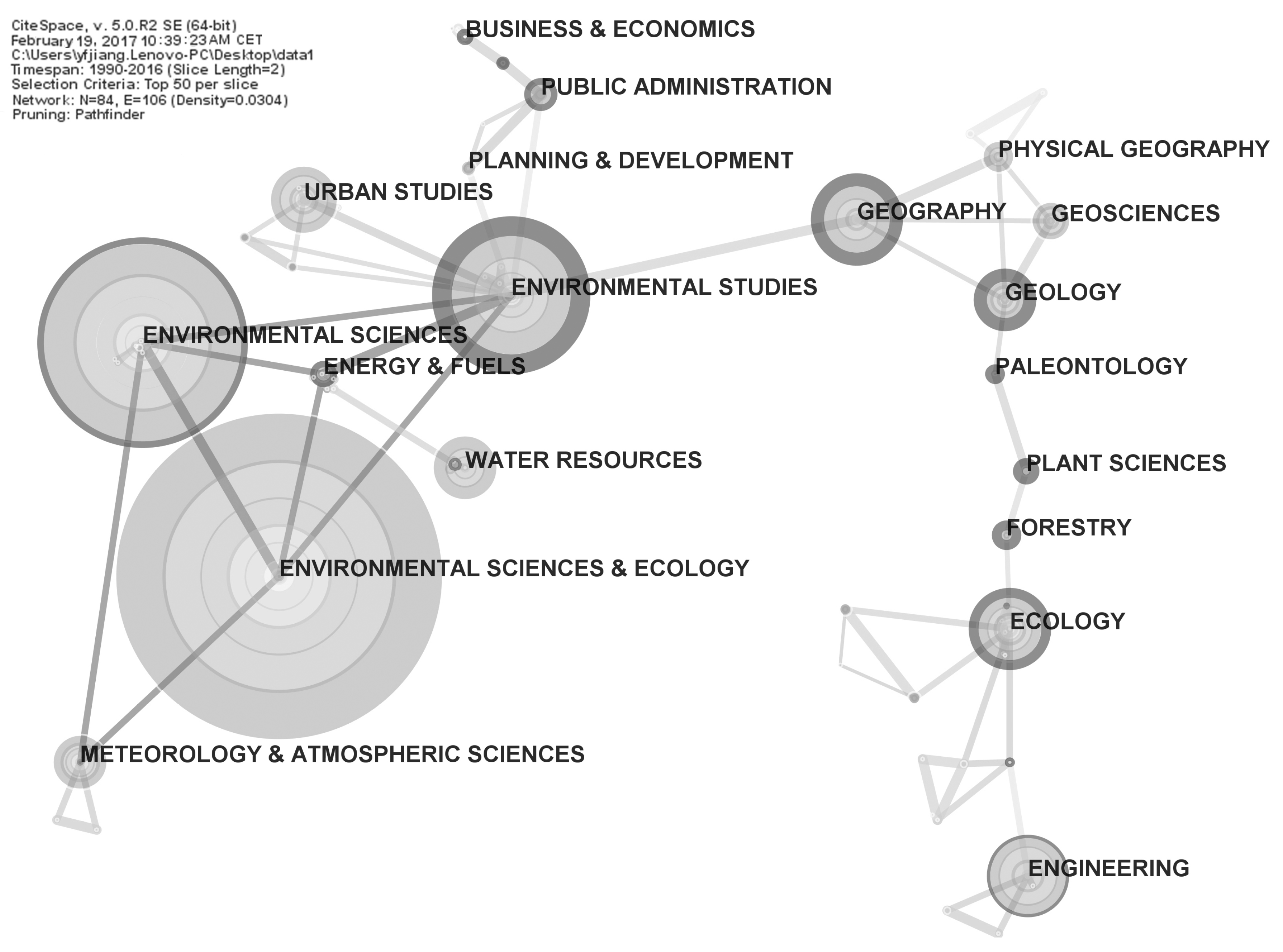
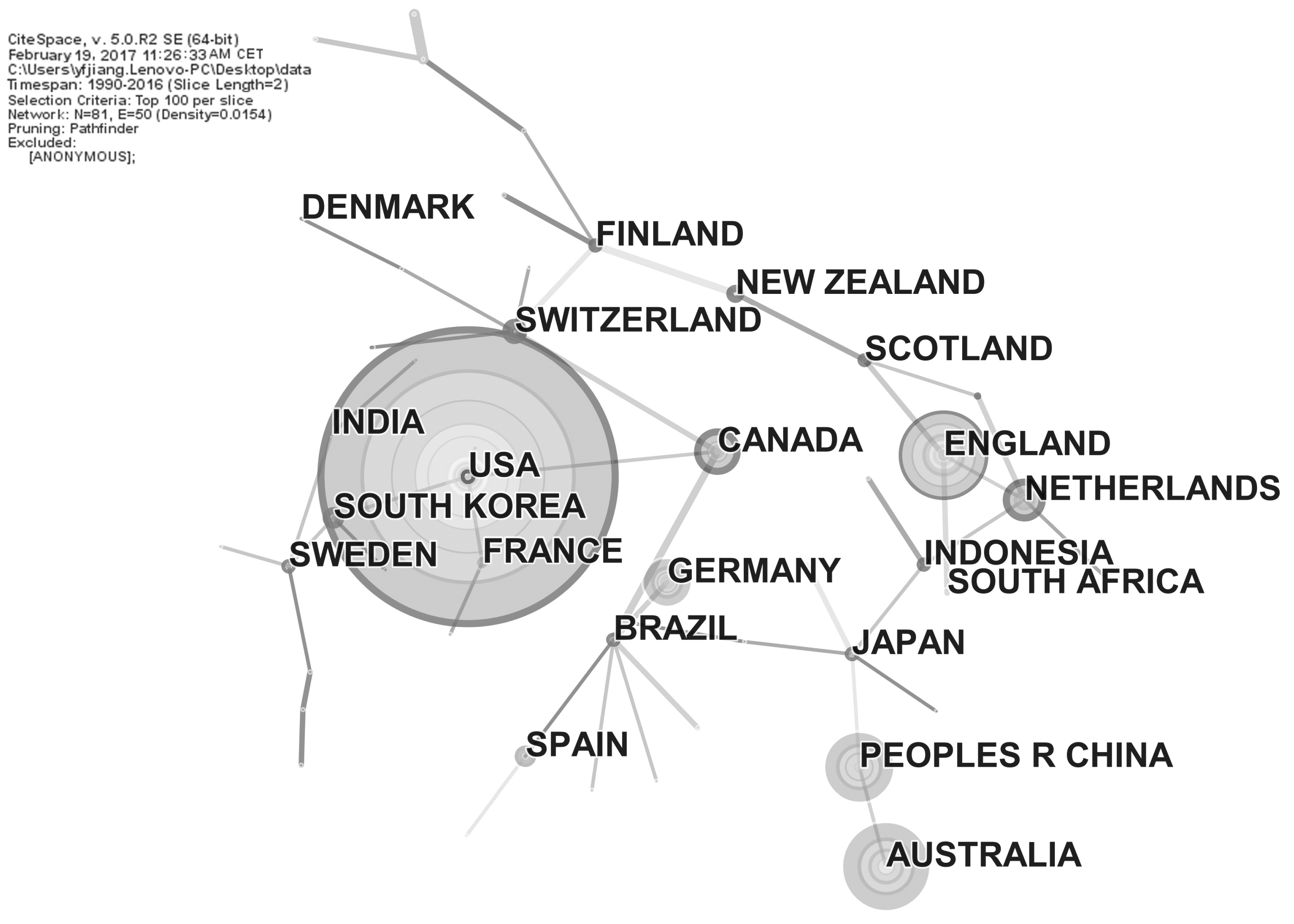


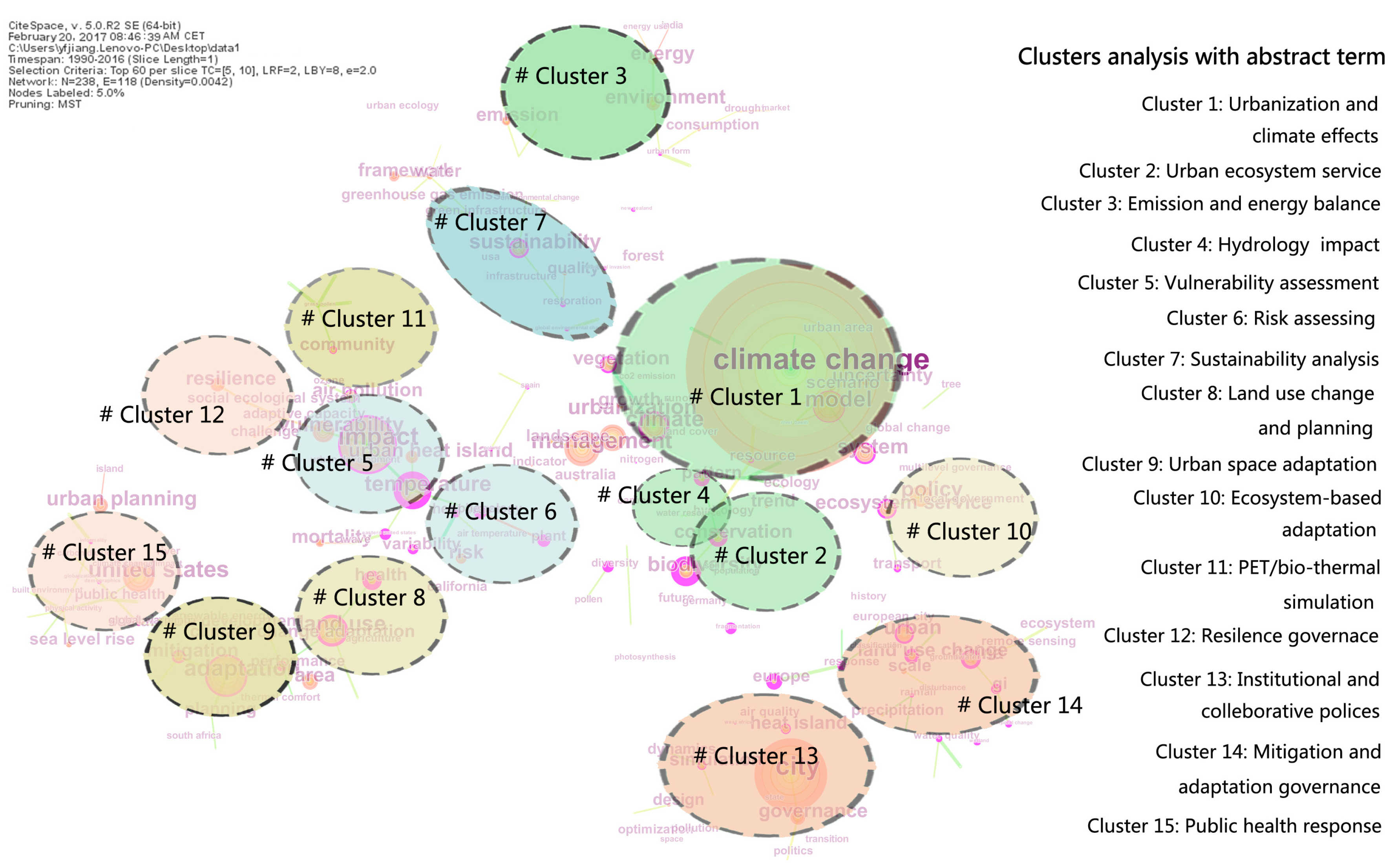
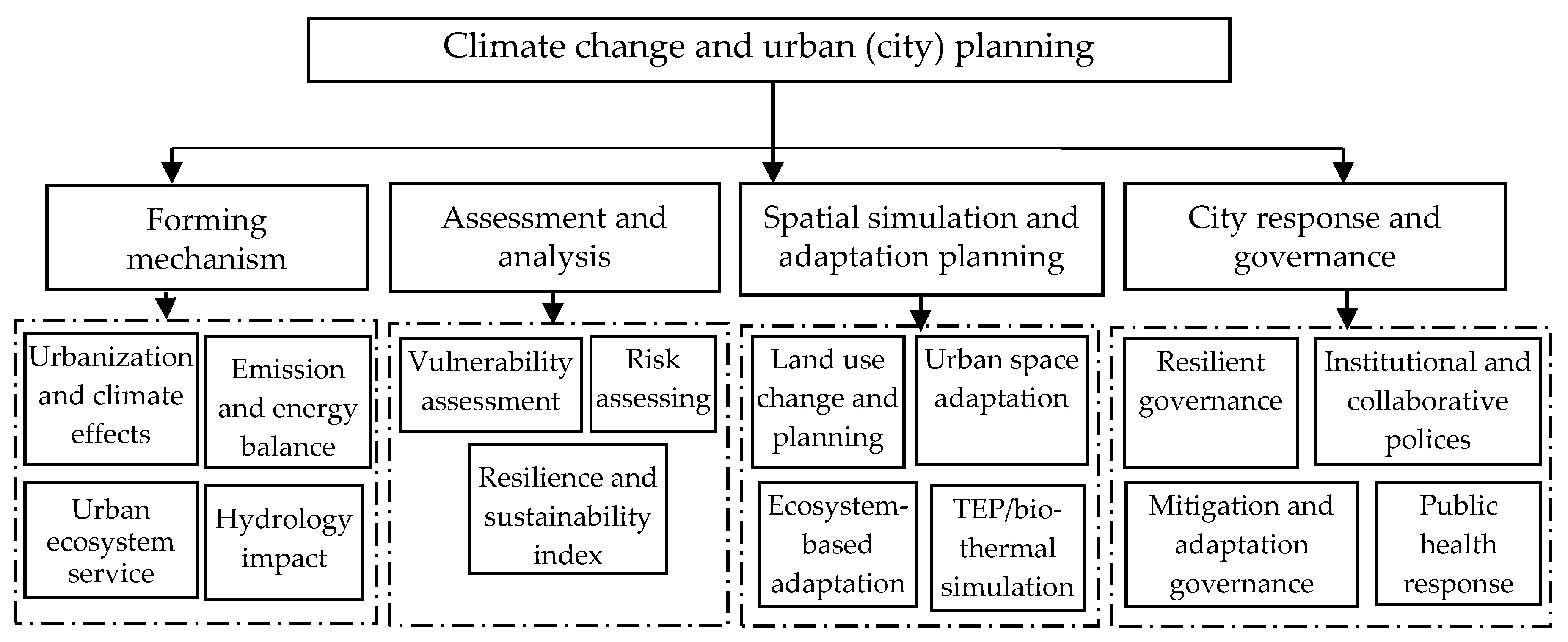
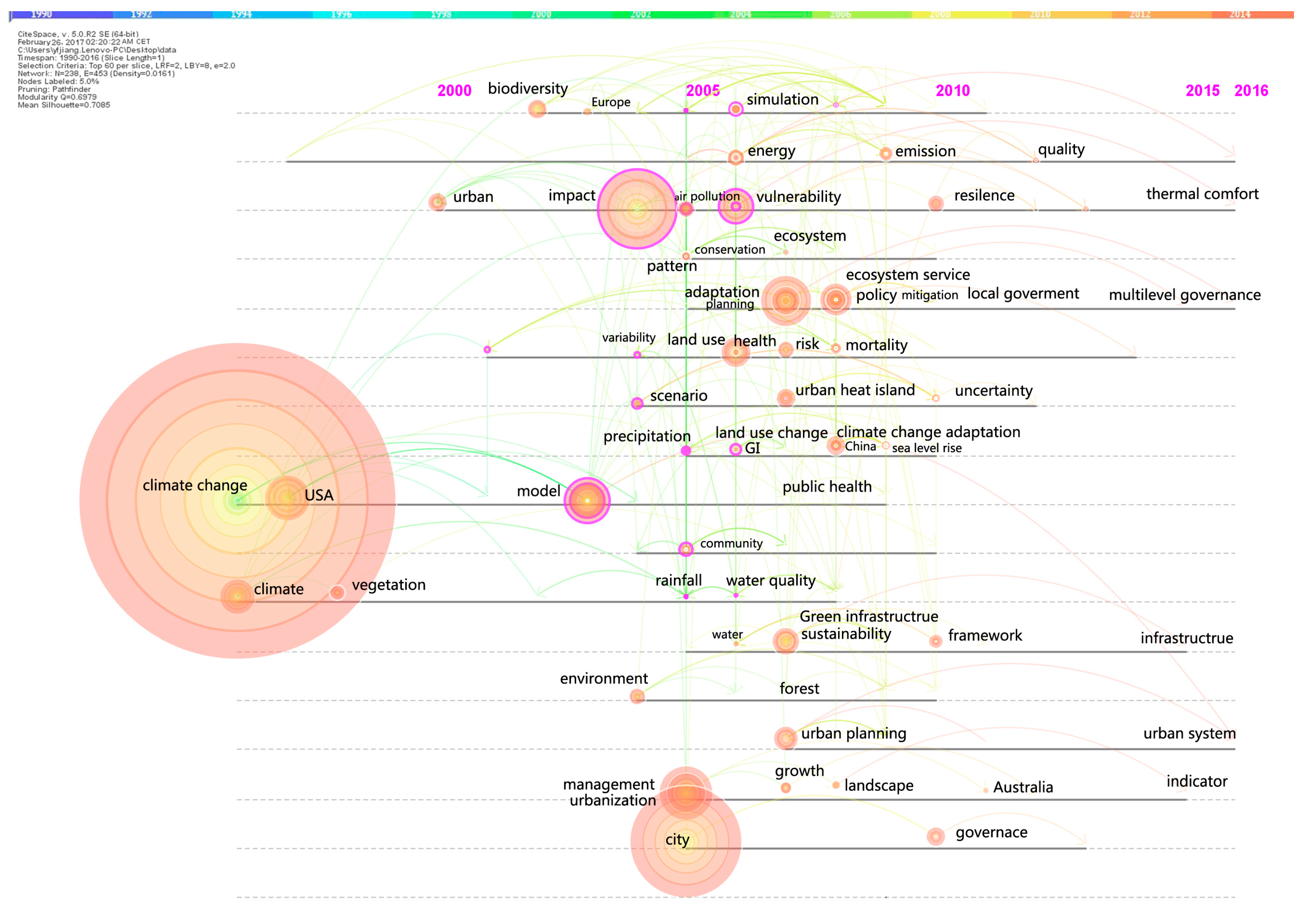
| Freq. | Author | Title | Source | Year | Cluster ID |
|---|---|---|---|---|---|
| 1498 | Folke, C.; Hahn, T.; Olsson, P.; Norberg, J. | Adaptive governance of social-ecological systems [67] | Annual Review of Environment and Resources | 2005 | Cluster 14 |
| 1331 | Smit, B.; Wandel, J. | Adaptation, adaptive capacity and vulnerability [68] | Global Environmental Change | 2006 | Cluster 5 |
| 1289 | Grimm, N.B.; Faeth, S.H.; Golubiewski, N.E.; Redman, C.L.; et al. | Global Change and the Ecology of Cities [3] | Science | 2008 | Cluster 14 |
| 1242 | Adger, W.N. | Vulnerability [74] | Global Environmental Change | 2006 | Cluster 5 |
| 1114 | Mckinney, M.L. | Urbanization, Biodiversity, and Conservation [75] | BioScience | 2002 | Cluster 1 |
| 1049 | Seager, R.; Ting, M.; Held, I.; Kushnir, Y.; et al. | Model Projections of an Imminent Transition to a More Arid Climate in Southwestern North America [76] | Science | 2007 | Cluster 4 |
| 824 | Arnfield, A.J. | Two decades of urban climate research: a review of turbulence, exchanges of energy and water, and the urban heat island [77] | International Journal of Climatology | 2003 | Cluster 1 |
| 712 | Rosenfeld, D. | Suppression of Rain and Snow by Urban and Industrial Air Pollution [78] | Science | 2000 | Cluster 1 |
| 656 | Fitter, A.H.; Fitter, R.S. | Rapid changes in flowering time in British plants [79] | Science | 2002 | Cluster 2 |
| 636 | Voogt, J.A.; Oke, T.R. | Thermal remote sensing of urban climates [80] | Remote Sensing of Environment | 2003 | Cluster 1 |
| 562 | Mcgranahan, G.; Balk, D.; Anderson, B. | The rising tide: assessing the risks of climate change and human settlements in low elevation coastal zones [81] | Environment and Urbanization | 2007 | Cluster 6 |
| 369 | Campbell, S. | Green Cities, Growing Cities, Just Cities?: Urban Planning and the Contradictions of Sustainable Development [72] | Journal of the American Planning Association | 1996 | Cluster 9 |
| 366 | Taha, H. | Urban climates and heat islands: albedo, evapotranspiration, and anthropogenic heat [82] | Energy and Buildings | 1997 | Cluster 3 |
| 253 | Bulkeley, H.; Betsill, M. | Rethinking Sustainable Cities: Multilevel Governance and the ‘Urban’ Politics of Climate Change [51] | Environmental Politics | 2005 | Cluster 13 |
| 250 | Semenza, J.C.; Mccullough, J.E.; Flanders, W.D.; Mcgeehin, M.A.; Lumpkin, J.R. | Excess hospital admissions during the July 1995 heat wave in Chicago [73] | American Journal of Preventive Medicine | 1999 | Cluster 15 |
| 172 | Pickett, S.T.A.; Cadenasso, M.L.; Grove, J.M. | Resilient cities: meaning, models, and metaphor for integrating the ecological, socio-economic, and planning realms [71] | Landscape & Urban Planning | 2004 | Cluster 12 |
| 179 | Bulkeley, H.; Kern, K. | Local Government and the Governing of Climate Change in Germany and the UK [69] | Urban Studies | 2006 | Cluster 13 |
| 169 | Brazel, A.; Selover, N.; Vose, R.; Heisler, G. | The tale of two climates-Baltimore and Phoenix urban LTER sites [83] | Climate Research | 2000 | Cluster 1 |
| 166 | Whitford, V.; Ennos, A.R.; Handley, J.F. | “City form and natural process”—indicators for the ecological performance of urban areas and their application to Merseyside, UK [84] | Landscape and Urban Planning | 2001 | Cluster 2 |
| 130 | Wheeler, S.M. | State and Municipal Climate Change Plans: The First Generation [70] | Journal of the American Planning Association | 2008 | Cluster 13 |
| Academic Communities | The Reference Frequency of Citation Burst ≥2 | The Reference Frequency of Citation Burst ≥5 | Representative Citation Bursts References (before the Year 2000) | Representative Citation Bursts References (after the Year 2000) |
|---|---|---|---|---|
| Urbanization and climate effects | 3 | 0 | Watson, V., 2009 [88] | Yu, M., 2012 [89]; Debbage, N., 2015 [90] |
| Urban ecosystem service | 9 | 4 | Kong, F.H., 2014a [91]; Kong, F.H., 2014b [92]; Maimaitiyiming, M., 2014 [93]; Cavan, G., 2014 [94] | |
| Emission and energy balance | 5 | 3 | Kjellstrom, T., 2007 [58] | Gurney, K.R., 2012 [22]; Liu, Z., 2012 [23] |
| Hydrology impact | 2 | 1 | Wilby, R.L., 2012 [95]; Gober, P., 2010 [96] | |
| Vulnerability assessment | 3 | 0 | Sampson, N.R., 2013 [97]; Weber, S., 2015 [98]; Kumar, P., 2016 [99] | |
| Risk assessing | 2 | 1 | Gwilliam, J., 2006 [29] | Horton, R.M, 2011 [100] |
| Sustainability assessment | 4 | 1 | Musacchio, L.R., 2009 [101] | Milan, B.F., 2015 [102]; Suarez, M., 2016 [103]; Kotzee, I., 2016 [49] |
| Land use change and planning | 10 | 3 | Roy, M., 2009 [104] | Viegas, C.V., 2013 [31]; |Dugord, P.A., 2014 [30] |
| Urban space adaptation | 16 | 7 | Lindley, S.J., 2006 [6]; Blanco, H., 2009a [105]; Blanco, H., 2009b [106] | House-TEPers, L.A., 2011 [107]; Burley, J.G., 2012 [26]; Reyer, C., 2012 [108]; Picketts, I.M., 2014 [109]; Hamin, E.M., 2014 [110] |
| Ecosystem-based adaptation | 5 | 4 | Lafortezza, R., 2013 [40]; Lehmann, I., 2014 [42]; Demuzere, M., 2014 [43]; Geneletti, D., 2016 [44] | |
| TEP/bio-thermal simulation | 7 | 5 | Muller, N., 2014 [111]; Abreu-Harbich, L.V., 2014 [112]; Jamei, E., 2016 [113]; Algeciras, J.A.R., 2016a [114]; Algeciras, J.A.R., 2016b [115]. | |
| Resilience governance | 2 | 1 | Meerow, S., 2016 [116]; Hung, H.C., 2016 [50] | |
| Institutional and collaborative polices | 19 | 1 | Ng, M.K., 2012 [52]; Picketts, I.M., 2012 [117]; Reckien, D., 2014 [118]; Reckien, D., 2015 [119]; Wamsler, C., 2015 [120]; Wamsler, C., 2016 [121] | |
| Mitigation and adaptation governance | 16 | 4 | McEvoy, D., 2006 [55] | Poyar, K.A., 2010 [56]; Gore, C.D., 2010 [122]; Santamouris, M., 2014 [57]; Santamouris, M., 2015 [123] |
| Public health response | 12 | 9 | Kjellstrom, T., 2007 [58]; Luber, G., 2008 [59]; Jackson, R., 2008 [60]; Campbell-Lendrum, D.C., 2007 [61]; Patz, J., 2008 [62]; Kinney, P.L., 2008 [63]; Younger, M., 2008 [64]; ONeill, M.S., 2009a [65]; ONeill, M.S., 2009b [66] |
© 2017 by the authors. Licensee MDPI, Basel, Switzerland. This article is an open access article distributed under the terms and conditions of the Creative Commons Attribution (CC BY) license (http://creativecommons.org/licenses/by/4.0/).
Share and Cite
Jiang, Y.; Hou, L.; Shi, T.; Gui, Q. A Review of Urban Planning Research for Climate Change. Sustainability 2017, 9, 2224. https://doi.org/10.3390/su9122224
Jiang Y, Hou L, Shi T, Gui Q. A Review of Urban Planning Research for Climate Change. Sustainability. 2017; 9(12):2224. https://doi.org/10.3390/su9122224
Chicago/Turabian StyleJiang, Yunfang, Luyao Hou, Tiemao Shi, and Qinchang Gui. 2017. "A Review of Urban Planning Research for Climate Change" Sustainability 9, no. 12: 2224. https://doi.org/10.3390/su9122224
APA StyleJiang, Y., Hou, L., Shi, T., & Gui, Q. (2017). A Review of Urban Planning Research for Climate Change. Sustainability, 9(12), 2224. https://doi.org/10.3390/su9122224




